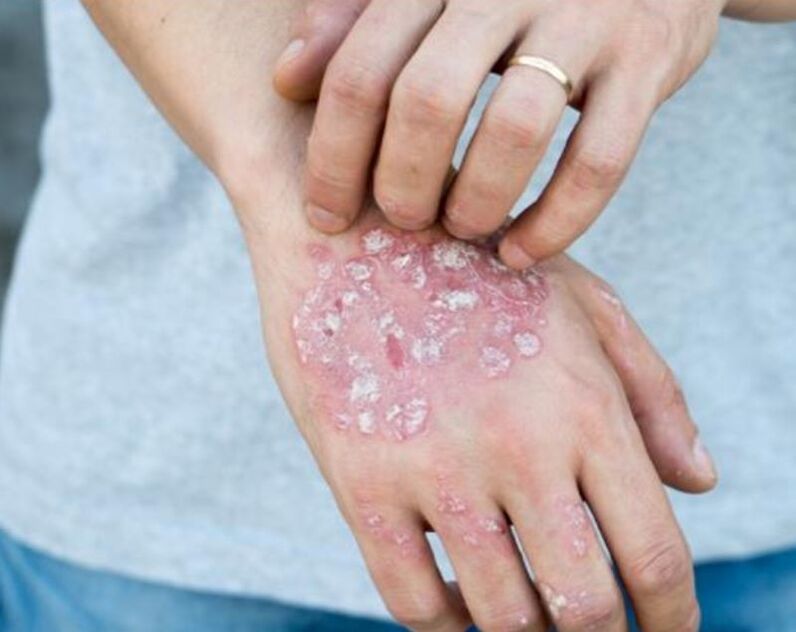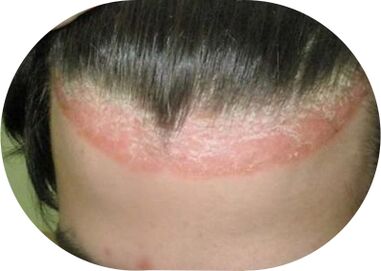Psoriasis is one of the most common skin diseases, and every hundredth resident suffers from this disease.
Psoriasis is a disease in which several factors are important at the same time: hereditary predisposition (psoriasis in relatives) to nervous, endocrine, immune system disorders and other factors.

Reasons
The causes of psoriasis have not been fully studied.
The principle of the mechanism of the disease is to disrupt the division of skin cells, which causes an autoimmune reaction (autoimmune reaction - occurs inside the body, regardless of external threats).
The upper layer of the skin (epidermis) consists mainly of keratinocytes - cells that produce keratin. Keratin is a protein, the properties of which allow it to perform the protective function of the skin. Keratinocytes form in the deeper layers of the epidermis and slowly move to the surface, maturing during movement and acquiring new features.
At the end of "maturation", keratinocytes form the stratum corneum on the surface of the skin. Then the keratinized cells die and are stripped of life, thus ending the life cycle of keratinocytes. This ensures continuous skin renewal.
The normal path of keratinocytes from the deep layer to the surface takes a month. With psoriasis, their lifespan is reduced to a few days, which leads to the formation of scaly, psoriatic foci because the skin does not have time to get rid of keratinized cells.
When seen, psoriatic plaques are usually accompanied by itching and redness. This indicates an autoimmune reaction in the deeper layers of the skin, resulting in swelling of the thicker layer of skin (dermis). The dermis contains blood and lymphatic vessels.
It is not clear why the process of keratinocyte formation is accelerated, but it is known that an inherited factor plays an important role.
The development of common psoriasis can begin with:
- conditions of mental trauma and constant stress;
- skin damage;
- transmitted infectious disease;
- taking certain medications;
- hormonal diseases;
- allergic reactions (typical allergens: citrus fruits, eggs, chocolate);
- alcohol intoxication;
- climate change.
The psoriatic triad is a characteristic feature of the disease that occurs when the skin is broken.
Stearin stain(Increased peeling after shaving gives the appearance of a drop of stearin crushed on the surface of the papules).
Thermal film(appearance after the scales of a wet, thin, shiny, transparent surface are completely removed).
Bloody bleeding(appearance of incoherent blood droplets).
What happens to the skin in psoriasis?
In psoriasis, the structure of the skin is disrupted, the epidermis is thinned, the processes of keratinization of the skin (accumulation of keratin protein) are disrupted, and some layers of normal epidermis disappear. In the next stage of the disease, groups of cells responsible for inflammation are found in the corneum of the protective surface layer of the epidermis and around the dilated vessels of the skin, in the zone of parakeratosis.
Characteristic plaques and scales appear on the surface of the skin.
Psoriasis is not just a common disease, it has many manifestations and even hides itself like other diseases.

Localization of psoriasis:
- elbows and knees;
- sacrum and spine;
- scalp (seborrheic psoriasis);
- folds and wrinkles of the skin: the inner surface of the elbow and knee joints, groin and armpits, the area under the chest (reverse psoriasis);
- palmar and foot surfaces (palmar-plantar psoriasis);
- psoriasis of the nail plates.
General symptoms of psoriasis
The main symptoms of psoriasis are:
- psoriasis plaques;
- density of the affected skin area;
- itching.
Symptoms by type of psoriasis:
- exudative psoriasis (peeling and wetting of the affected areas of the skin, the formation of a yellow crust on the surface of the rash);
- intertriginous psoriasis (more common in children, the foci of formation are red, slightly peeled, sometimes wet ones can be confused with diaper rash);
- old psoriasis (characterized by large plaques that do not last long);
- rupioid psoriasis (another form of chronic psoriasis characterized by cone-shaped plaques);
- intestinal psoriasis (abundant rash of small papules).
Types of psoriasis
- Common psoriasis (vulgar, plaque);
- Generalized psoriasis (widespread, postural);
- Psoriasis in the form of tears (depending on the type of rash);
- Arthropathic psoriasis (with joint damage);
- Other types of psoriasis (seborrheic and others).
Psoriasis vulgaris is the most common form of the disease.
Psoriasis begins in typical places: often a small number of rashes on the elbows and knees. In addition, the characteristic localization of the rash is the scalp and trunk area. In general, there is a clear relationship between the appearance of rashes and the action of the stimulus.
Factors that provoke psoriasis can include stress, skin trauma, recent infections, and regular alcohol intake.
In general, the exacerbation of the disease occurs in the cold season - this is a type of winter psoriasis. Summer type is more rare. Mixed forms of psoriasis are now noted. Over time, the number of spills increases. They form characteristic psoriatic plaques. Kebner's phenomenon is observed - the appearance of new plaques at the sites of skin trauma. As a rule, patients have plaques on the skin without inflammation.
The disease runs through the cycle:
- Progressive stage (increase in the number of rashes);
- Stationary stage (no new spills appear);
- Regressive stage (regression of rashes, appearance of skin areas without pigment).
Psoriasis vulgaris, photo



Diagnostics
When diagnosing psoriasis, a thorough examination of the skin is required first.
Delicate skin, bleeding in places, loose plaques are signs of psoriasis. When these symptoms occur, the doctor performs a number of diagnostic measures to rule out the presence of other events with similar manifestations. Blood tests, spots, and skin biopsies are performed as needed for a final diagnosis. If the joints are affected, magnetic resonance imaging (MRI) is performed and X-rays are taken to identify the lesions.
Psoriasis vulgaris, treatment
Psoriasis is a systemic disease with skin manifestations and requires complex treatment: both local and systemic treatment. The disease is chronic and treatment is aimed at reducing the number and severity of exacerbations and achieving a skin condition that is acceptable to the patient.
In the advanced stage of psoriasis, all aggressive procedures are eliminated: ultraviolet radiation, baths. It is important for patients with psoriasis to handle the skin carefully and carefully so as not to cause inflammation and damage to the formation of new plaques.
Diet for psoriasis
Psoriasis is often accompanied by liver disease, so it is important to avoid alcohol, fatty, fried, smoked foods. It is equally important to be moderate in carbohydrate intake, as this changes the pH of the skin and increases the risk of rash.
Prophylaxis
Prevention of psoriasis is to maintain a healthy lifestyle. This prevents other diseases from occurring because the body's immune system is protected from stress and can withstand external threats.
Measures to prevent psoriasis include:
- appropriate skin care;
- soothing massage to improve blood circulation;
- it is advisable to eat properly, avoid allergenic foods and exclude (limit) the intake of spicy, fatty, acidic, smoked, salty foods and citrus fruits;
- dairy-vegetable diet;
- sufficient moisture in the body;
- elimination of alcohol and smoking and other bad habits;
- increased physical activity;
- walks outdoors;
- avoid stressful situations;
- Getting vitamins of groups A, B, C, D, E;
- The choice of loose clothing of natural materials that will not chalk and will not cause irritation.
It is a tool for the treatment of psoriasis
Systematic therapy for psoriasis is aimed at reducing the proliferation of skin epithelium, stabilizing keratinization of skin cells and cell membranes. For this purpose, preparations based on vitamin A (retinoids), cytostatics are used. The most modern treatments use so-called biological agents that neutralize substances that cause inflammation.
UFO has been used for years - treatment with group B ultraviolet rays (in tanning beds, rays of group A), which reduce inflammation and promote the death of altered cells. PUVA therapy is also the use of a special substance that increases the sensitivity of the skin to ultraviolet radiation.
It is an effective tool for psoriasis
Local treatment is no less important than systemic treatment. Helps reduce skin inflammationMedications are prescribed depending on the stage of psoriasis.
Progressive stage
- exfoliating ointments and lotions;
- anti-inflammatory hormonal ointments with calcitriol;
- emollients to relieve itching and dry skin.
Stationary stage
- UVB therapy;
- concentrated exfoliating ointments;
- emollients to restore the skin and reduce dryness.
Regressive stage
- concentrated exfoliating ointments;
- emollients to restore the skin and reduce dryness.
Psoriasis cream
Creams and ointments for psoriasis have different purposes and are used in different stages of the disease. Hormonal anti-inflammatory ointments and creams are used to stop inflammatory processes in the skin. There are several classes of hormonal drugs. They have different absorption abilities and different activities. When used in children, they try to prevent the application of hormonal drugs to the face and neck area, the area of skin wrinkles - the areas where the skin is more delicate. Topical preparations based on calcipotriol (a derivative of vitamin D) also contain antioxidants. inflammatory effect. These are the next generation drugs. Currently not used during pregnancy and lactation.
Salicylic ointment and salicylic acid lotion are designed to cleanse the skin from severe crumbs. Salicylic acid not only has an exfoliating effect, but also enhances the effect of local hormonal drugs. In the stationary and regressive stages, when inflammation is less active, salicylic acid-based substances are used in higher concentrations.
Means to restore the structure of the skin and eliminate dryness are used throughout the treatment period and in combination with ultraviolet radiation to reduce itching of the skin. Once the flames are reduced, these products help maintain the skin's protective properties and reduce the risk of new breakage.
An effective cream for psoriasis
The modern approach to the care and assistance of dry skin is based on the saturation of the epidermis with moisture and is called cornea therapy ("cornea" - cornea or horn, layer of epidermis).
Corneotherapy is aimed at restoring the stratum corneum of the epidermis and its protective functions, which allows to improve the condition of the skin as a whole. The work of Albert Kligman, the founder of corn therapy, allowed to create special means - emollients.
How do softeners work?
Within 1 hour after applying emollients: - The condition of the skin improves as it "binds" the moisture inside the emollients.
6 hours after the application of emollients: - Thanks to the composition of special restorative natural lipids (ceramides and other essential oils), the structure of the skin is restored.
24 hours after application of emollients: - Clinical improvement of skin condition occurs as a result of penetration of moisturizing components into the deeper layers of the epidermis and the restoration of the surface layers of the skin (up to 24 hours after application of the drug). .























